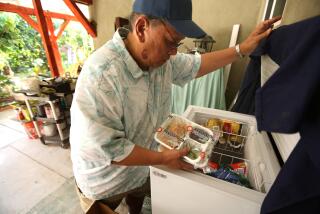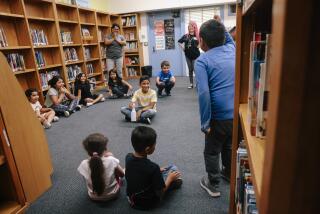A Child’s Hunger Knows No Season
- Share via
RAYMOND, Wash. — Children start trickling into the small city park about 11 a.m. Most walk up, holding younger siblings by the hand or pushing strollers. Others arrive on bikes, some with training wheels.
They scramble into line when Cindy Wyburg pulls up to the weathered gazebo at 11:20, the back of her Bronco packed with coolers full of food. They open the rear door before she’s even made it out of the driver’s seat.
“Today is turkey and cheese,” Wyburg announces as she hands out sandwiches, chocolate milk and paper sacks filled with fruit and vegetables. She lets them take as much as they want. Wyburg knows this may be the only meal they get today.
Summertime is hunger time for thousands of children throughout the nation.
During the school year, about 350,000 Washington children get free breakfast and lunch through a federal program. Nationwide, 15.5 million children participate. When school ends, so do the free meals.
The summer food program, also federally funded, is supposed to fill the gap. But child advocates say the program reaches only about 12% of children who need it.
Last year, the Raymond School District’s summer meal program supplied 8,400 meals in Pacific County, one of the state’s poorest counties. They’re on pace to provide more than 10,000 meals this year.
“A lot of the kids, if they didn’t come here and eat lunch, they wouldn’t eat lunch,” Wyburg said.
Lorraine Riley sits at the graffiti-scarred picnic table and watches her boyfriend’s two children eat. Riley makes sure the children get three square meals a day, but it’s not easy. She used to work at a cannery before she was injured; her boyfriend is a logger who’s “on call” for available jobs. They rely on food banks and neighborhood barbecues to keep everyone fed.
“They get filled up here for sure,” Riley said as Rayce, 4, popped grapes into his mouth. “I really appreciate these lunches.”
Western states have the highest hunger rates in the country. States with the top five hunger rates, according to the U.S. Department of Agriculture, are Oregon, 5.8%; Washington, 4.6%; Utah, 4.6%; Idaho, 4.5%, and Alaska, 4.3%.
And hunger isn’t confined to poor areas like Raymond. Just steps away from million-dollar beach-front condos in west Seattle, a banner in front of lush green soccer fields advertises “Free Food for Kids” at the Alki Community Center. At noon, children line up for chicken fingers or bagels with ham and cheese. They return for snacks at 3, usually a juice box and chips or cookies. Often, they arrive early.
“It’s just so hard to say, ‘No, you have to wait until 3,’ when you know they’re starving,” said Jill Patterson, the center’s youth program coordinator.
The meal program cost about $2.5 million last year in Washington. Schools, churches, city and county governments, tribes and private nonprofit agencies such as the YMCA can operate meal programs. This year, 78 sponsors and 62 schools are operating meal programs at 600 sites throughout the state. Dozens more communities could qualify for federal funding but don’t have a meal program because of concerns about cost or paperwork.
The program sometimes costs more than the federal government’s reimbursement rate -- in which case local operators must make up the difference. Transportation is the biggest hurdle. In rural areas, unless money is available to operate school buses, children have no way of getting to the meals.
Sometimes, the communities that most need the program can’t afford it.
In Ellensburg, the school district ran a successful summer food program for about five years at Mount Stuart Elementary, across from a low-income housing project. But when budget cuts forced the district to cancel summer school, the free summer meals vanished too.
Ellensburg food services supervisor Gwen Sorenson hopes the district will resume summer school and the summer meal program next year. She doesn’t know what’s happening to all the children she saw every summer at lunchtime, holding the hands of their grandparents or older brothers.
“People think parents should be taking care of their children,” Sorenson said. “But in the world we live in today, that isn’t always possible.”
Demand at food banks usually peaks in the summer, and this year the poor economy may cause an even higher spike in need, said Maria Lamarca Anderson, spokeswoman for Northwest Harvest. The nonprofit organization distributes food to about 300 soup kitchens and food banks throughout the state.
The statewide monthly reports sent to Northwest Harvest’s central Seattle office describe food pantries running out, more new clients than ever and more desperation, Anderson said. About 40% of clients are children.
In Raymond, school food director Dale Hendrickson is amazed at how the demand for free meals keeps increasing, while the school-age population shrinks. The timber- and fishing- dependent area has lost many jobs recently and people are moving away. Those who stay need more help than before, Hendrickson said, which is why the summer food program is one of his passions.
“Kids need to eat in the summer too,” he said.
More to Read
Sign up for Essential California
The most important California stories and recommendations in your inbox every morning.
You may occasionally receive promotional content from the Los Angeles Times.









